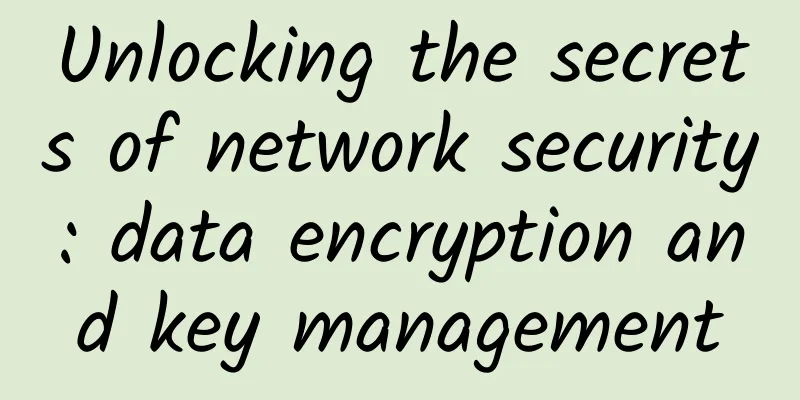Unlocking the secrets of network security: data encryption and key management

|
In this digital age where data is like gold, how can we protect our information from hackers? The answer lies in data encryption and key management. Today, let's explore the mysteries behind these technologies and learn how to ensure information security in a scientific way. 1. What is data encryption? Data encryption is the process of converting plaintext data into unrecognizable ciphertext through a specific algorithm. Only those with the correct key can decrypt the ciphertext and restore it to plaintext. It's like we lock important documents in a safe, and only those with the key can open it and view it. 2. Common encryption algorithmsSymmetric encryptionSymmetric encryption uses the same key for encryption and decryption. Common symmetric encryption algorithms include AES and DES. Its advantage is fast encryption speed, but the security management of the key is more complicated. Asymmetric encryptionAsymmetric encryption uses a pair of public and private keys. The public key is used for encryption, and the private key is used for decryption. Common asymmetric encryption algorithms include RSA, ECC, etc. Its advantage is that key management is relatively simple, but the encryption speed is slow. 3. Challenges of Key ManagementKey management is a critical step in ensuring the security of cryptographic systems. The main challenges include key generation, storage, distribution, and update. Key GenerationKey generation requires the use of a high-quality random number generator (RNG) to ensure the security of the key. A low-quality RNG may generate keys that are easily cracked. Key storageKeys must be stored in a secure location to prevent unauthorized access. Hardware Security Modules (HSMs) are common key storage devices that provide both physical and logical protection. Key DistributionDistributing keys securely is a complex process, especially in a network environment. Common methods include key exchange protocols such as Diffie-Hellman and the use of a trusted third party such as a CA. Key UpdateRegularly changing keys can improve the security of the system and prevent data leakage caused by key leakage. Key updates need to be closely coordinated with various parts of the encryption system to ensure a smooth transition. 4. Technical Implementation SolutionSymmetric encryption using AES 2. Asymmetric encryption using RSA 5. Case Study: Encryption and Key Management in Banking SystemsIn the banking system, encryption and key management are crucial. Customers' sensitive information (such as account numbers, passwords, etc.) needs to be encrypted throughout the transmission and storage process. Banks usually use symmetric encryption (such as AES) to encrypt large amounts of data, and use asymmetric encryption (such as RSA) to securely distribute and exchange keys. Hardware security modules (HSMs) play an important role in ensuring the secure storage and management of keys. VI. ConclusionData encryption and key management are core technologies for protecting digital information security. By understanding and mastering these technologies, we can effectively prevent data leakage and hacker attacks. Both individual users and corporate organizations should attach importance to and implement these security measures to cope with the increasingly severe challenges of network security. |
Recommend
How does SD-WAN compare to VPN?
When enterprises compare SD-WAN vs. VPN services,...
5G and edge computing are a perfect match
Enterprise IT leaders have heard a lot about edge...
When purchasing a wireless router, which one is better, “single-band” or “dual-band”?
In this era where we cannot live without the Inte...
Do you always feel that the Internet speed is slow? You may be in trouble
We say that there are many reasons for slow Inter...
5G, IoT, edge and cloud: a winning combination
The number of 5G connections is expected to grow ...
China Mobile slams on the brakes. What is the reason?
Recently, the three major operators represented b...
Why does 5G need edge computing (MEC)?
[[354637]] This article is reprinted from the WeC...
Building a streaming data lake using Flink Hudi
This article introduces how Flink Hudi continuous...
A Five-Star End-User Experience Requires Unified Digital Experience Management
Introduction To deliver a five-star digital exper...
Maxthon Hosting: Hong Kong VPS monthly payment starts from 40 yuan, US CU2VIP line VPS monthly payment starts from 38 yuan
Continuing to share information about Maxthon Hos...
How to Understand and Evaluate Potential Colocation Data Center Providers?
Today, as demand for colocation and wholesale dat...
Cutting in while driving is annoying. WiFi actually takes up lanes too.
Friends who often drive often encounter the pheno...
12 minutes to help you understand the OSI seven-layer model and the TCP/IP five-layer model
1. OSI Reference Model 1. Origin of OSI OSI (Open...
Required course: VLAN is so important! Share VLAN planning and configuration examples in two most common scenarios!
1. Common scenario 1 - restaurant/hotel 1. Backgr...









